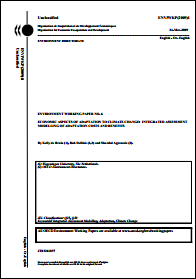Economic Aspects of Adaptation to Climate Change: Integrated Assessment Modelling of Adaptation Costs and Benefits


Abstract
The present report seeks to inform critical questions with regard to policy mixes of investments in adaptation and mitigation, and how they might vary over time. This is facilitated here by examining adaptation within global Integrated Assessment Modelling frameworks.
None of the existing Integrated Assessment Models (IAMs) captures adaptation satisfactorily. Many models do not specify the damages from climate change, and those that do mostly assume implicitly that adaptation is set at an “optimal” level that minimizes the sum total of the costs of adaptation and the residual climate damages that might occur.
This report develops and applies a framework for the explicit incorporation of adaptation in Integrated Assessment Models (IAMs). It provides a consistent framework to investigate “optimal” balances between investments in mitigating climate change, investments in adapting to climate change and accepting (future) climate change damages. By including adaptation into IAMs these already powerful tools for policy analysis are further improved and the interactions between mitigation and adaptation can be analysed in more detail.
To demonstrate the approach a framework for incorporating adaptation as a policy variable was developed for two IAMs– the global Dynamic Integrated model for Climate and the Economy (DICE) and its regional counterpart, the Regional Integrated model for Climate and the Economy (RICE). These modified models – AD-DICE and AD-RICE – are calibrated and then used in a number of policy simulations to examine the distribution of adaptation costs and the interactions between adaptation and mitigation.
Using the limited information available in current models, and calibrating to a specific damage level, socalled adaptation cost curves are estimated for the world. Adaptation cost curves are also estimated for different regions, although given the limited information available to calibrate the regional curves these should be considered as rough approximations of the actual adaptation potential in the different regions. These adaptation cost curves reflect how different adaptation levels will provide a wedge between gross damages (i.e. damages that would occur in the absence of adaptation) and residual damages.
The analysis presented suggests that a good adaptation policy matters especially when suboptimal mitigation policies are implemented. Similarly, a good mitigation strategy is more important when optimal adaptation levels are unattainable. The rationale for this result is that both policy control options can compensate to some extent for deviations from the efficient outcome caused by non-optimality of the other control option. It should be noted, however, that in many cases there are limits to adaptation with regard to the magnitude and rate of climate change.
The higher the current value of damages, the more important mitigation is as a policy option in comparison to adaptation. The comparison between adaptation and mitigation therefore depends crucially on the assumptions in the model, and especially on the discount rate and the level of future damages.
The policy simulations also suggest that to combat climate change in an efficient way, short term optimal policies would consist of a mixture of substantial investments in adaptation measures, coupled with investments in mitigation, even though the latter will only decrease damages in the longer term. The costs of inaction are high, and thus it is more important to start acting on mitigation and adaptation even when there is limited information on which to base the policies, than to ignore the problems climate change already poses. Ongoing increases in expected damages over time imply that adaptation is not an option that should be considered only for the coming decades, but it will be necessary to keep investing in adaptation options, as both the challenges and benefits of adaptation increase. The results of these policy simulations confirm the findings of the Intergovernmental Panel on Climate Change (IPCC) on the relationship between adaptation and mitigation as described in the SynthesisReport of the Fourth Assessment Report.
The framework developed in this report opens the door for further simulations that examine adaptation cost issues within other, more complex IAMs. The model additions investigated in this report can also shed light on how the next generation of IAMs will look. These tools can also be further strengthened by the incorporation of more detailed regional knowledge on the impacts of climate change and of adaptation options
Citation
de Bruin, K., R. Dellink and S. Agrawala (2009). “Economic Aspects of Adaptation to Climate Change: Integrated Assessment Modelling of Adaptation Costs and Benefits,” OECD Environment Working Papers 6, OECD Publishing.
(0) Comments
There is no content